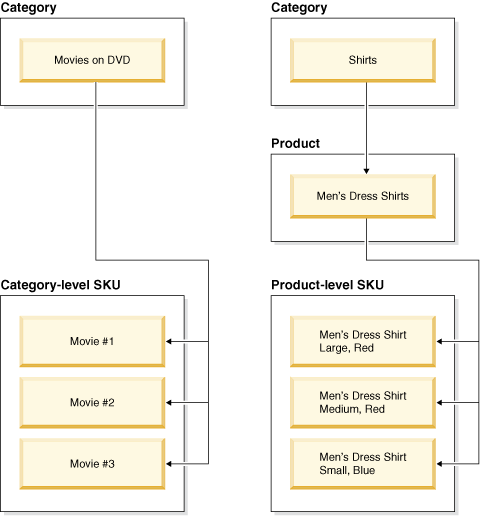Catalog entries
A catalog entry is merchandise in an online catalog that includes a code, a name, a description, one or more offer prices, images, and other details. There are four types of catalog entries: products, SKUs, bundles, and kits.
Catalog entries can be a single item (atomic) or composed of several other catalog entries (composite). An atomic catalog entry is an individually orderable entity that needs no further SKU resolution. For example, an atomic item such as a shirt in the color blue, size small can be added to a shopping cart for purchase. In this example the shirt represents an atomic item because it has a SKU and is orderable. When composite, a catalog entry represents unresolved products or bundles that may need additional information before becoming atomic entities. Composite catalog entries are those items that are not individually orderable. For example, a men's shirt represents a composite item that requires further SKU resolution based on size and color before it can be orderable.
 Products
Products
Products are templates
for SKUs, the individual pieces of merchandise that are ultimately
sold to a customer. The product describes the general characteristics
of the merchandise, and the SKU distinguishes the differences between
the merchandise. For example, the shirt product is
available in two colors and three sizes. There are six possible SKUs
for this product.
Product variants
Product variants help you organize your products by attribute. A variant is a list of SKUs that all share the same attribute value. For example, you could create a variant for shoes based on the color attribute. This variant would let you select all shoe SKUs by color and work with just that set of SKUs.
 SKUs
SKUs
- Product-level SKU
- Create your product; then create SKUs to represent each orderable item of merchandise for sale. All SKUs related to a particular product exhibit the same set of attributes and are distinguished by their defining attribute values. For example, each color and size combination of the shirt product is one SKU.
- Category-level SKU
- Create SKUs under a category that is not associated with any product. This type of SKU is created for products that do not have defining attributes. For example, a DVD product might not have any defining attributes.
The following image describes the differences between category-level SKUs and product-level SKUs.

 Bundles
Bundles
A bundle is a collection of catalog entries that allow customers to buy multiple merchandise with one click. For example, when a bundle for a computer system is a computer, a monitor, a printer, and a scanner, the bundle components can be sold separately. The price of a bundle is the sum of the prices of the products it contains.
 Kits
Kits
A kit is a collection of catalog entries that cannot be sold separately. For example, a computer kit might contain a specific processor, monitor, and hard disk drive. A kit has its own price and can be added to the shopping cart. Viewed in similar ways as a product, a kit can have descriptive attributes.
Inventory for a prebuilt kit is independent of the inventory of its component parts. For example, selling a computer prebuilt kit does not affect the inventory of the processor, monitor, and hard disk drive that the prebuilt kit contains.